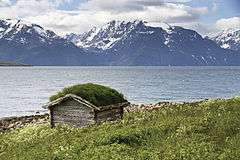Please tell us which country and city you'd like to see the weather in.

Lyngen (fjord)
Lyngen (also known as Norwegian: Lyngenfjorden, Northern Sami: Ivgovuotna, Kven: Yykeänvuono) is a fjord in the municipalities of Skjervøy, Nordreisa, Lyngen, Gáivuotna–Kåfjord, and Storfjord in Troms county, Norway. The 82-kilometre (51 mi) long fjord is the longest fjord in Troms county. It stretches from the village of Hatteng in Storfjord in the south all the way north to the islands of Skjervøy. The Lyngen Alps lie along the western shore of the fjord and the European route E06 highway runs along the eastern shore. The Kåfjorden branches off of the main fjord on the east side, and the southernmost part of the fjord is also known as the Storfjorden.
Media gallery

A view of the Lyngenfjorden
A view of the Lyngenfjorden

Cod drying along the fjord
Cod drying along the fjord

View of the fjord under the northern lights
View of the fjord under the northern lights

View from Rottsund, Nordreisa
View from Rottsund, Nordreisa
See also

Troms
Troms [ˈtrʊms] (![]() listen) (Northern Sami: Romsa, Finnish: Tromssa) is a county in Northern Norway. It borders Finnmark county to the northeast and Nordland county in the southwest. Norrbotten Län in Sweden is located to the south and further southeast is a shorter border with Lapland Province in Finland. To the west is the Norwegian Sea (Atlantic Ocean).
listen) (Northern Sami: Romsa, Finnish: Tromssa) is a county in Northern Norway. It borders Finnmark county to the northeast and Nordland county in the southwest. Norrbotten Län in Sweden is located to the south and further southeast is a shorter border with Lapland Province in Finland. To the west is the Norwegian Sea (Atlantic Ocean).
The entire county, which was established in 1866, is located north of the Arctic circle. The Troms County Municipality is the governing body for the county, elected by the people of Troms, while the Troms county governor is a representative of the King and Government of Norway.
General information
Name
Until 1919 the county was formerly known as Tromsø amt. On 1 July 2006, the Northern Sami name for the county, Romsa, was granted official status along with Troms.
The county (and the city of Tromsø) is named after the island Tromsøya on which it is located (Old Norse Trums). Several theories exist as to the etymology of Troms. One theory holds "Troms-" to derive from the old (uncompounded) name of the island (Old Norse: Trums). Several islands and rivers in Norway have the name Tromsa, and the names of these are probably derived from the word straumr which means "(strong) stream". (The original form must then have been Strums, for the missing s see Indo-European s-mobile.) Another theory holds that Tromsøya was originally called Lille Tromsøya (Little Tromsøya), because of its proximity to the much bigger island today called Kvaløya, that according to this theory was earlier called "Store Tromsøya" due to a characteristic mountain known as Tromma (the Drum). The mountain's name in Sámi, Rumbbučohkka, is identical in meaning, and it is said to have been a sacred mountain for the Sámi in pre-Christian times.

Tromsø
Tromsø (Norwegian pronunciation: [ˈtrʊmsœ] (![]() listen); Northern Sami: Romsa; Finnish: TromssaKven: Tromssa) is a city and municipality in Troms county, Norway. The administrative centre of the municipality is the city of Tromsø. Outside of Norway, Tromso and Tromsö are alternative spellings of the city. Tromsø is considered the northernmost city in the world with a population above 50,000. The most populous city north of it is Alta, Norway, with a population of 14,272 (2013).
listen); Northern Sami: Romsa; Finnish: TromssaKven: Tromssa) is a city and municipality in Troms county, Norway. The administrative centre of the municipality is the city of Tromsø. Outside of Norway, Tromso and Tromsö are alternative spellings of the city. Tromsø is considered the northernmost city in the world with a population above 50,000. The most populous city north of it is Alta, Norway, with a population of 14,272 (2013).
Tromsø lies in Northern Norway. The municipality has a population of (2015) 72,066, but with influx of students it has over 75,000 most of the year. It is the largest urban area in Northern Norway and the third largest north of the Arctic Circle (following Murmansk and Norilsk). Most of Tromsø, including the city centre, is located on the island of Tromsøya, 350 kilometres (217 mi) north of the Arctic Circle. In 2012, Tromsøya had a population of 36,088. Substantial parts of the urban area are also situated on the mainland to the east, and on parts of Kvaløya—a large island to the west. Tromsøya is connected to the mainland by the Tromsø Bridge and the Tromsøysund Tunnel, and to the island of Kvaløya by the Sandnessund Bridge. Tromsø Airport connects the city to many destinations in Europe. The city is warmer than most other places located on the same latitude, due to the warming effect of the Gulf Stream.

Bids for the 2018 Winter Olympics
Three cities applied with bids to host the 2018 Winter Olympics and Paralympics (also known as XXIII Olympic Winter Games and XII Paralympic Winter Games) in October 2009. The International Olympic Committee, under the leadership of Jacques Rogge, received three bids on October 15, 2009. The cities of Annecy, France, in the French Alps, Munich, Germany (host of the 1972 Summer Olympics), and Pyeongchang, South Korea, a two-time previous bidder, competed for the hosting rights to the event. This was the lowest number of bidding cities since the 1988 Summer Olympics, coincidentally also won by South Korea. The winning bid was announced on July 6, 2011, at the 123rd IOC Session in Durban, South Africa by IOC President Jacques Rogge at 5.22 pm local time Pyeongchang beat Munich and Annecy in the first round of votes with 63 of the 95 total votes.
Bidding calendar
Radio Stations - Troms Fylke
SEARCH FOR RADIOS
Podcasts:

